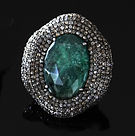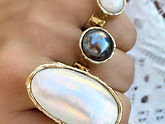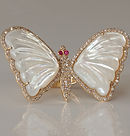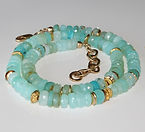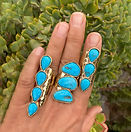Birthday Gemstones
Birthstones and their vivid colors have long been a way to connect your birth month with rare and unique gemstones.
They are a meaningful gift for mom, a friend, spouse, or family member during a special occasion. But they mean much more than that as you'll find out here.
The Origin Of Birthstones
Birthstones are gems associated with the month that a person was born. To start off, here's the list of each birthstone by month:
· January Birthstone: Garnet
· February Birthstone: Amethyst
· March Birthstone: Aquamarine
· April Birthstone: Diamond
· May Birthstone: Emerald
· June Birthstone: Pearl or Alexandrite
· July Birthstone: Ruby
· August Birthstone: Peridot
· September Birthstone: Sapphire
· October Birthstone: Tourmaline or Opal
· November Birthstone: Topaz or Citrine
· December Birthstone: Tanzanite, Zircon or Turquoise
"There were twelve stones, one for each of the names of the sons of Israel, each engraved like a seal with the name of one of the twelve tribes." (Exodus 28:17-20)
Birthstones appear to have a biblical source, tracing back to the book of Exodus in the Bible and specifically on the breastplate of Aaron. The breastplate was inlaid with 12 gemstones that each represented the twelve tribes of Israel at the time. This specific breastplate was adorned with the following gems: emerald, sapphire, diamond, topaz, carbuncle, sardius, agate, ligure, amethyst, onyx, jasper, and beryl.
How did these breastplate gems turn into the birthstones we all know today? Stepping forward to the 1st and 5th century AD two scholars, Flavius Josephus and St. Jerome, are credited with associating the 12 breastplate gems with the 12 signs of the zodiac. Initially, the thinking was that each person would own all 12 birthstones and wear each gem on the corresponding month.
The modern variation we know today came about in the 18th century in Poland whereby Jewish gem traders marketed selling each gemstone based on a person’s birth month. In 1912 the National Association of Jewelers solidified the practice in the United States. The twelve birthstones have largely remained the same since then, albeit with a few companies trying to pitch their gems into the mix to boost sales. Keep in mind there are different types and variations of birthstones, for instance birthstones for zodiac symbols such as gemini.












POLISHED BIRTHSTONES FOR EACH OF THE 12 MONTHS
Are Birthstones Gemstones Or Minerals?
One of the tenant building blocks of rocks are minerals, which geologists have a very precise definition for. In order to be technically a mineral, a substance must meet these five requirements. The substance must be naturally occurring (not man-made), inorganic, solid, with a definition chemical composition, and ordered internal structure.
Most of the birthstones listed above are gemstones that are technically classified as minerals. However, a pearl is not classified as a mineral since it is not inorganic as it grew inside a mollusk. In addition, opal in some instances can be either organic or inorganic and thus the organic version would not be considered a mineral.
What is defined as a gemstone is a more generic term used largely by the jewelry industry to denote a precious stone that has been cut, polished, and used in jewelry. The stone can be either made up of minerals such as diamonds or emeralds or other substances such as amber or pearls. Gems are often hard to find and hold an economic value largely dependent on their rarity.
January Birthstone: Garnet
Garnet has been used as a gemstone for over 5000 years. It has been found in the jewelry of many Egyptian burials and was the most popular gemstone of Ancient Rome.
Garnet is the birthstone for those that are born on the month of January. The word Garnet derives from the 14th century where "gernet" meant a deep red color. In addition, it is derived from the Latin word granatum, which means seed in this instance the seed of a pomegranate.
Garnet is typically a deep red gem that goes with just about any type of jewelry. It is actually a group of minerals as opposed to most on this list that are a specific mineral, hence the variations seen in the table below. Garnet can be found in metamorphic, igneous, or sedimentary rocks and can be of various grades. Garnets of low grade are typically used in abrasive water jets that work to remove coatings or rust.
Color: Red, brown, black, green, yellow, orange, pink, white, and colorless. Very rarely blue


February Birthstone: Amethyst
An amethyst is the birthstone for those born in the month of February. The term amethyst derives from the ancient Greek word methustos, which translates roughly to intoxicated. In ancient Greece, it was believed that if you wore an amethyst it would protect you from getting drunk.
Actually, amethyst is a variety of quartz. The same quartz that covers white sandy beaches, is the source of glass, and is one of the most common minerals on Earth. Specifically, an amethyst is produced when there are certain impurities in quartz that gives it the purple coloration.
The deep purple of an amethyst gemstone has long signified royalty and adorns many crowns and royal jewelry. It is meant to exude wealth and power with its warm and cool color. You can often find amethyst in geodes at your local rock shop. Color: purple, violet
March Birthstone: Aquamarine
Aquamarine is the birthstone for those lucky enough to be born in March. The word aquamarine is a combination of two words, aqua meaning water, and marina, meaning the sea. Therefore, the gem is named after the beautiful blue sea. Part of the history of this gem is that it was used by sailors to give them good luck on the seas and to ensure a safe voyage.
Aquamarine is in fact a type of beryl, a rare silicate miner
al that is found in igneous and metamorphic rocks around the world. Specifically, it is found in granite rhyolites and granite pegmatites. A primary source of beryl is mined at Spor Mountain in Utah, albeit that is typically not for gemstone quality.
Beryl can be found in a variety of colors and each color is given a different name. Beryl colors and their names are as follows: emerald (green), aquamarine (blue), red beryl (red), heliodor (yellow), morganite (pink to orange), maxixe (dark blue), green beryl (light green), and the rare colorless version goshenite (colorless)
Color: Green, blue, yellow, colorless, pink and occasionally others


April Birthstone: Diamond
You've surely heard of or even own a diamond, the birthstone for the month of April. Diamonds are one of the rarest gemstones in the world and certainly one of the most prized. They earn that recognition partially for how hard they are, in fact they are 58 times harder than any other mineral on Earth. That is why you will often see diamond coated blades and bits as they are able to cut or grind through anything.
Diamonds are a pure carbon lattice as shown above and come in a range of colors from yellow to red, pink, green, and blue. However, you likely are interested in the pure colorless variety of diamonds, which are extremely rare as most diamonds have a hint of yellow to them.
Diamonds are carbon that undergoes extreme temperatures and pressures below the surface of the Earth. They are then exhumed to the surface often times through volcanic magma pipes called kimberlite pipes. They have been valued for thousands of years in civilizations around the world and were once thought to be lightning on Earth. Today, they're commonly given as engagement rings as popularized by De Beers.
Color: Typically yellow, brown, or gray to colorless. Rarely a diamond can be blue, green, black, translucent white, pink, violet, orange, purple, or red.

May Birthstone: Emerald
Emerald is the birthstone for those born in the month of May. The word emerald is derived from the Greek word smaragdus which translates to green. Similar to aquamarine as mentioned above, an emerald is a green variety of beryl based on the impurities found in the beryl.
Emeralds are found commonly in Brazil, Colombia, Zambia, and Afghanistan. Most emeralds are heat treated to deepen their green color as high-quality emeralds are very rare. Cleopatra is known to have loved emeralds and claimed ownership of every single emerald mine in Egypt during her rule.
The emerald is part of the "big three" colored gemstones in addition to ruby and sapphire. These big three gemstones create more economic value than all other gemstones combined. Beryl picks up its green color from trace amounts of chromium or vanadium along with trace amounts of iron to give it a bluish green color.
Color: Green to colorless


June Birthstone: Pearl or Alexandrite
Pearls are your lucky birthstone if you were born in the month of June. The word pearl comes from the French word perle which means led. This refers to the leg shape of a mollusk shell.
Pearls are gemstones but not minerals as pearls are formed by living organisms, mollusks. A mollusk will form a pearl if there is a nucleus to start, sometimes an individual grain of sand. The mollusk will then corm layers of calcium carbonate around that sand grain sequentially over time. Actually, the mollusk does this because the grain is an irritant and this is the reaction to ease that irritant by adding a smooth coating around it.
The majority of pearls you find in the marketplace today are actually cultured in a pearl farm where people artificially induce creation of a pearl through insertion of an irritant into the mollusks shell. Most pearls come from southern China, Indonesia, Philippines, and Australia.
Color white, pink, silver, cream, brown, green, blue, black, yellow, orange, gold, purple, or iridescent


July Birthstone: Ruby
If you're lucky and were born in July, ruby is your birthstone of the month. Ruby is a variety of corundum which is then colored to a deep red coloring by chromium. One of the other variations of corundum is sapphire dependent on the impurities within the mineral. The name of ruby comes from the Latin word for red, Rubeus.
One of the most famous locations for rubies is the Mogok Valley in Burma, known for its deep blood red colored rubies. You can also find rubies in the United States, Thailand, Vietnam, and India. Not surprising, the ruby is known to represent life and blood and is known to increase courage. In fact, warriors in Burma would implant rubies into their skin before battle for protection and courage on the battlefield.
Color: Pink to all shades of red to deep crimson, colorless



August Birthstone: Peridot
Peridot is your birthstone if you were born in the month of August. This gemstone has a green vibrant glow and possibly derives its name from the Arabic word for gem, faridat. It may also derive its name from the Greek word for "giving plenty," peridona.
Peridot is actually gem quality olivine, a mineral commonly found in mafic igneous rocks such as basalt, gabbro, and peridotite. Peridot is often found along divergent plate boundaries and hot spots such as Hawaii. In fact, Hawaiian folklore says that peridot symbolizes the tears of the volcano goddess Pele. While olivine is a common mineral, its less common to have the gem quality version of the mineral, peridot.
Most of the gem quality peridot in the world comes from the San Carlos Reservation in Arizona, however it can be found in Pakistan, Myanmar, and China. The San Carlos Apache Indian Reservation is estimated to produce up to 95 percent of the world's peridot supply.
Color: Yellow, yellow-green, olive-green, brown, occasionally lime-green, emerald green



September Birthstone: Sapphire
If you were born in September your birthstone is the sapphire. Similar to a ruby, a sapphire is a variety of corundum that adorns a deep blue color. The name sapphire comes from the Latin word for "blue stone," sapphirus. One of the benefits of sapphires is their hardness, registering a 9 on the Mohs hardness scale (diamond is a 10). This means it's a strong and sturdy gemstone that you don't have to worry about getting scratched. It also means this gem is useful for industrial that take heavy wear and tear.
You can find deep blue sapphires from Kashmir in India, which is known for producing some of the best sapphires in the world. You can also find sapphires in Australia and Madagascar. The corundum takes on the blue coloring from trace amounts of both titanium and iron.
Color: Typically blue

October Birthstone: Tourmaline or Opal
If you were lucky enough to be born in the month of October, your birthstone is both tourmaline and opal. Tourmaline comes from the Sinhalese word for mixed colored stone, tura mali. In fact, tourmaline is not a single mineral, it is a group of minerals that have very different chemical compositions and colors. A tourmaline is a boron silicate mineral that occur within igneous and metamorphic rocks.
The other birthstone is opal, which gets its name from the Greek word opallios. This roughly translates into "to see a change in color" as demonstrated when you spin an opal. Opal forms when water picks up silica dioxide and deposits it into open voids or cavities along with trace impurities. The water then evaporates and leaves the silica dioxide. Most of the opal in the world is produced from Australia, where seasonal rains make it common for water to leach out silica and deposit it into cracks within the ground.
Color: Typically black, but can range from colorless to yellow, orange, blue, red, green, pink, violet, or bi-colored (watermelon tourmaline)


November Birthstone: Topaz or Citrine
Both topaz and citrine are the birthstones associated with the birth month of November. Topaz is the more common gemstone associated with November and comes in a variety of yellow hues. The name topaz comes from the Greek name for St. John's Island located in the Red Sea, Topazios. This is because yellow gems were mined on this island, however they were likely not topaz.
Topaz picks up its bright yellow color from impurities, as with most gems. In pure form, topaz is colorless but can take on a variety of colors dependent on certain impurities. A large chunk of the topaz in the world comes from Brazil, however it's also produced in Australia, Russia, Sri Lanka, India, Pakistan, Nigeria, Mexico, Germany, and the United States. Although topaz has been used in many forms for thousands of years, the term was widely used for any light-yellow gem and hence most references to topaz in history could be other gems.
Color: Yellow, blue, brown, gray, pink, reddish pink, orange, colorless if there are no impurities



December Birthstone: Tanzanite, Zircon or Turquoise
There are three birthstones for the month of December: tanzanite, zircon and turquoise. All three of these stones are a deep blue color and have their own history and chemical composition. One of the more interesting of the three is tanzanite, a gem you may not have heard of before. This rare gem is only found in Tanzania and was only recently discovered in 1967. Tanzanite gets its deep blue color from trace amounts of vanadium.
Tanzanite was discovered by Maasai herders who were tending to the Merelani Hills around Arusha, Tanzania. These herders came across blue crystals and notified a prospector who then registered the area with the government to begin mining. The name Tanzanite was coined by Tiffany and Company who became the primary distributor of the gem and wanted to showcase the rare geographical source of this stone.
Color: Blue, violet































